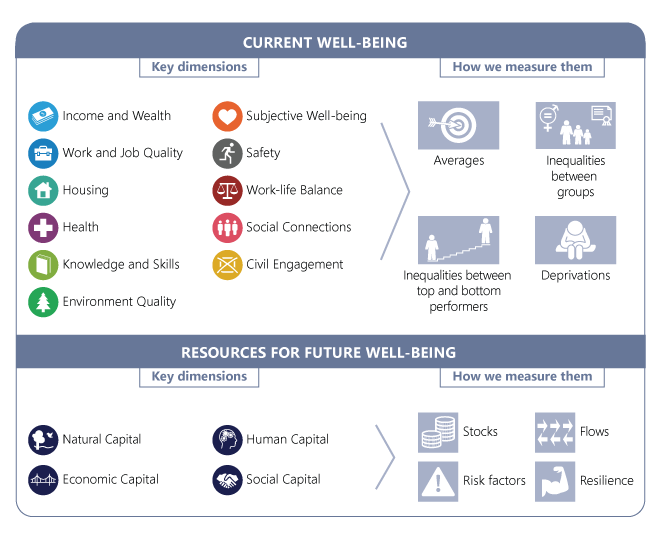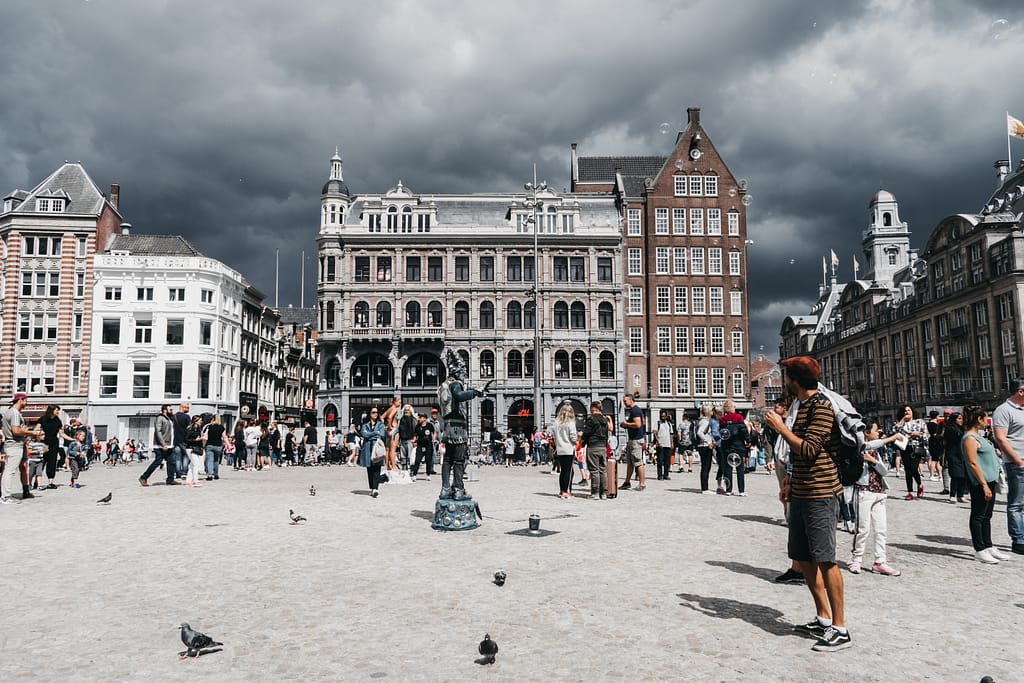Principles of a ‘wellbeing economy’ are being put into action, with new frameworks and indicators on the rise. Against a backdrop of growing inequality, environmental degradation, and human health challenges, around the globe governments are shifting their priorities.
Central in modern society, money stands tall and proud. In the same way the Inuit have a rich vocabulary to describe the prevalent snow in their lives, Western culture has many words to describe money’s pivotal role in society – ‘capitalism’, ‘free-market’, ‘finance’, ‘profit’, ‘interest’, ‘inflation’, ‘stock markets’ and ‘gross domestic product (GDP)’, to name a few. With this strong societal focus, GDP has firmly held the reins since the 1940s as the primary performance indicator of national welfare.
With GDP continually growing, human economic progress is seemingly successful. In less than 100 years, global GDP rose by an estimated 35 times, from over $2 billion to more than $77 billion. Yet improvements in the world’s average life satisfaction, which currently stands at 6.5 out of 10, by far doesn’t match this momentous growth.

What’s measured naturally becomes the goal
This capital growth-based economic system even values activities that damage society and the environment for short term gain. As an example, GDP currently encapsulates monetary increases from weapons, factory pollution, plastic production, pharmaceutical drugs, divorce, and CO2 emissions from rising consumption.
‘Ultimately, if we measure something, that’s what we steer towards. If we measure wellbeing, that is what we will look to enhance in the performance of our economies’, says industrial ecologist Eva Gladek, CEO of sustainable systems agency Metabolic. To achieve social progress and the betterment of wellbeing, it requires measuring the diverse experiences and living conditions of people, as well as economic indicators. This then naturally reorientates societal goals and expectations for politics, business, and society.

Countries implementing a wellbeing economy aim to improve quality of life
In a wellbeing economy, the goal is to deliver a higher standard of life while protecting the planet’s resources and environment for future generations. But how much is a tree or a traditional celebration worth? Creating a wellbeing economy means putting measurable values on qualitative experiences and natural resources.
Several countries are doing this, as they take the lead on implementing wellbeing economic principles. The best-known example is the Kingdom of Bhutan, the first nation to implement a Gross National Happiness Index in 2008. The government uses these metrics to inform its policies. This arguably results in improved governance, conservation of the environment, preservation and promotion of culture, and sustainable and equitable socio-economic development.
More recently, New Zealand released its first wellbeing budget in 2019. “Success is about making New Zealand both a great place to make a living, and a great place to make a life.” said the minister of finance Grant Robertson, when revealing the plan. Within the budget, the country has prioritized children’s wellbeing, mental health, indigenous culture, productivity, economic transformation, and investment.
Scotland is another first mover. “Growth in GDP should not be pursued at any and all cost … The goal of economic policy should be collective well-being,” says Scotland’s First Minister Nicola Sturgeon. She leads Scotland in prioritizing its National Performance Framework, and in measuring the results to deliver national outcomes. For example, Scotland’s natural environment is considered a strong contributor to wellbeing and the economy; the assets of their natural capital are estimated to be worth £273 billion.
Elsewhere in Europe, Iceland recently put wellbeing ahead of GDP, with Prime Minister Katrin Jakobsdottir saying that a key factor driving the inclusion of new indicators is environmental devastation. Also developing a set of wellbeing indicators, Slovenia is enhancing the wellbeing of its citizens and promoting awareness in creating social progress.
Even the bigger economic forces are taking action
As the tides turn, movements from big economic forces are coming into view. Since last year, the European Council has been calling on member states – and the European Commission – to include an ‘Economy of Wellbeing’ perspective in both national and union policies. Furthermore, on the other side of the Atlantic, the concept of Buen Vivir is taking root in South American nations. This is a worldview prioritizing harmony with nature and is a principle to guide state action.
In the wake of the COVID pandemic, China is acknowledging that annual GDP growth targets will, for the moment, have to be put aside. Premier Li Keqiang explains that they will “give priority to stabilizing employment and ensuring people’s livelihood, resolutely win the battle to overcome poverty, and strive to achieve the goal of building a moderately prosperous society.”

Independent organizations help enable the shift towards future wellbeing
But will there be a collective shift or will countries and companies act independently? Spearheading the transition together, is a network of countries and companies that make up the Wellbeing Economy Alliance. This organization provides the opportunity to learn from one another, sharing the most competent frameworks and statistical methods. Although, governments may also decide to develop an independent vision and framework, depending on potential differences in, for example, values or stages of development.
When it comes to implementation, the Organisation for Economic Co-operation and Development (OECD) has established the independent Wellbeing Economy Framework. This tracks current well-being as well as resources for future wellbeing.
Putting the lives and wellbeing of people first
Undoubtedly, there will be challenges to changing the structure of a system in a state of inertia for over more than half a century. The study Challenges For The Degrowth Transition points out that an attribute of the current market capitalist system, is that economic growth is needed to stabilize modern societies – a fairly recent phenomenon which only took shape in the 19th century. Although a growth-based economic system is relatively new, its foundational role in both political structures and social mindsets (success and status), poses a challenge. Such a transition needs to be well-managed to ensure there is no ground for new social conflict.
Implementing the wellbeing economy successfully puts the lives and wellbeing of people at the center of policy design. This allows people to stand tall and proud at the core of society. In the words of Lorenzo Fioramonti, Minister of Education of Italy and author of ‘Wellbeing Economy’, “In this new economy, people will be productive by performing activities that enhance the quality of life of their peers and the natural ecosystems in which they live. If not for moral reasons, they should do so for genuine self-interest: there is nothing more rewarding than creating well-being for oneself and society.”




